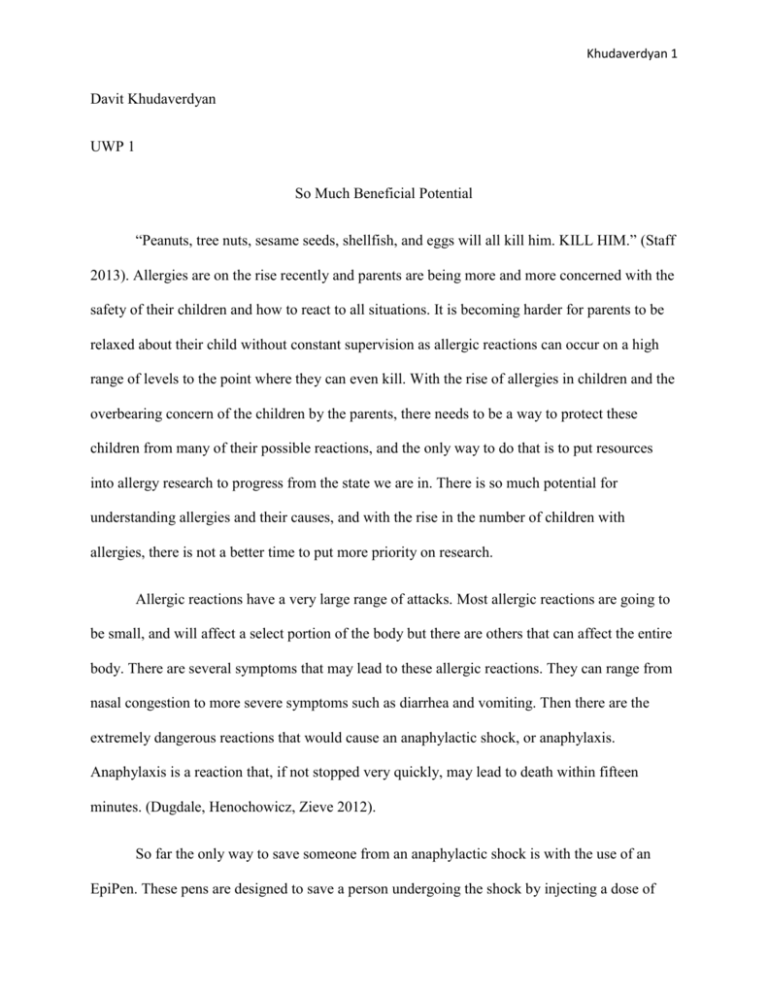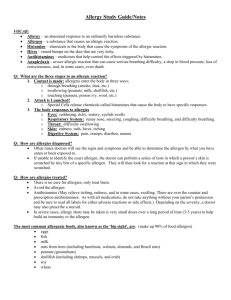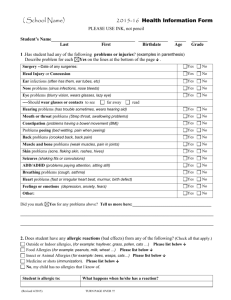Assignment 4 Draft 2
advertisement

Khudaverdyan 1 Davit Khudaverdyan UWP 1 So Much Beneficial Potential “Peanuts, tree nuts, sesame seeds, shellfish, and eggs will all kill him. KILL HIM.” (Staff 2013). Allergies are on the rise recently and parents are being more and more concerned with the safety of their children and how to react to all situations. It is becoming harder for parents to be relaxed about their child without constant supervision as allergic reactions can occur on a high range of levels to the point where they can even kill. With the rise of allergies in children and the overbearing concern of the children by the parents, there needs to be a way to protect these children from many of their possible reactions, and the only way to do that is to put resources into allergy research to progress from the state we are in. There is so much potential for understanding allergies and their causes, and with the rise in the number of children with allergies, there is not a better time to put more priority on research. Allergic reactions have a very large range of attacks. Most allergic reactions are going to be small, and will affect a select portion of the body but there are others that can affect the entire body. There are several symptoms that may lead to these allergic reactions. They can range from nasal congestion to more severe symptoms such as diarrhea and vomiting. Then there are the extremely dangerous reactions that would cause an anaphylactic shock, or anaphylaxis. Anaphylaxis is a reaction that, if not stopped very quickly, may lead to death within fifteen minutes. (Dugdale, Henochowicz, Zieve 2012). So far the only way to save someone from an anaphylactic shock is with the use of an EpiPen. These pens are designed to save a person undergoing the shock by injecting a dose of Khudaverdyan 2 epinephrine to the outer thigh. These epinephrine pens must be carried around all the time for those who have the allergies that can cause an anaphylactic shock. People have to carry these EpiPens to the point where they “create a ritual and a system in place that’s repetitive because that helps us to remember so it becomes a part of our every day.” (Martin 2013). Without these epinephrine pens people can potentially die if they have allergies and suffer an anaphylactic shock. Without much research, there have not been many improvements on inhibiting these reactions from occurring. However, another form of treatment has been used before, oral immunotherapy. Oral immunotherapy is trying to treat the allergy by giving the patient extremely small doses of the allergen in order to build up a resistance. Similar to oral immunotherapy, there is also the sublingual immunotherapy (SLIT), “where the allergen is held under the tongue” (AAAAI, 2012). There is not a clear sign of which method is better preferred, but there are results that would indicate that one is better than the other. Researchers have found that OIT (oral immunotherapy) is far better at “desensitizing to milk, with only 1/10 subjects on SLIT passing the challenge after 15 months, compared to 14/20 on OIT. “ (AAAAI, 2012). Unfortunately, by using OIT and actually swallowing the allergen can come with side effects involving respiratory, gastrointestinal, and other body reactions. Kari Nadeau, an M.D./Ph.D. which she received from Harvard, has done many trials in which she helped desensitize many children from their allergies by performing OIT. She focuses on the idea that allergies and the environment are intertwined and that the environment causes certain allergic reactions in people. Her idea is that “some element of interaction between genes and the environment — air pollution, tobacco smoke, chemicals in water or the food you eat. We are ingesting the proteins that are causing the allergies in a very different form and immune Khudaverdyan 3 environment than when primitive man did.” (Thernstrom, 2013). Initially she specialized in doing “ediatrics residency, specializing in oncology-hematology.” (Thernstrom, 2013). She was unable to detach herself from the pain of seeing her patients having to go through chemotherapy, and she found it hard to bear the idea that the treatment also brought upon the pain. Because of how her dissertation was on the immune system she decided to instead switch to that field of immunology and allergies. (Thernstrom, 2013). With her reputation she was contacted for information on allergies and for treatment plans for many parents’ children. She has used the method of oral immunotherapy to treat many children and to build their immune systems for the future. Patients of hers were given one milligram of an allergen and were slowly built up. With EpiPens ready, the child would swallow the delicate portion of the allergen. For example, one of the patients was given one milligram of flour made from the proteins of her allergen and “Over the course of treatment, she would increase the amount to 4,000 to 6,000 milligrams of each food — the equivalent of about 2 pieces of toast, 1 egg, 1 cup of milk, 16 peanuts and 16 almonds.” (Thernstrom, 2013). However, these kinds of therapies do not fully cure the body of allergens. Should patients avoid the therapy for a certain period of time, they will regain their reactivity to the allergens. “Importantly, both researchers and patients should realize that, after 15 months of maintenance treatment, desensitization can be lost after a short period of avoidance.” (AAAAI, 2012). While it seems like oral immunotherapy and sublingual immunotherapy can be answers to food allergies, it is clear that they are not permanent cures or inhibitors or allergic reactions. That is why research for a permanent or long lasting allergy cure needs to be in demand. Khudaverdyan 4 Unfortunately, now only those two methods and having to use an epinephrine injector are the ways to stop an allergic attack. The best way is to strictly avoid the allergen entirely. However, even with research continuing, there is no true progression to finding a cure of allergic reactions. Many high level professionals and doctors are working to find out more about allergies and how they have expanded over the years. Many studies have concluded that peanut allergies have greatly increased over the last decade in children, however, not so much in adults. Many of these doctors have long term experiments that need to be completed to find out whether some therapies such as the OIT can actually completely desensitize or at least bring up the tolerance of the allergen. (“ADVANCING A CURE”). Unfortunately with all this research, there has not been too much progress for the cause of such a great increase in allergic reactions. As of now there are no known causes for allergy attacks. One hypothesis that has been drawn up recently was the hygiene hypothesis. “While staying germ-free can prevent the spread of disease and infections, leading a cleanlier lifestyle may be responsible for an increase in allergies among children.” (“The Hygiene Hypothesis”, 2007). The changing lifestyle of humans over the years to a highly vaccinated and clean society has potentially increased allergy statistics over the years. Since bodies do not have the need to fight many of the germs that they had to in the past, they have switched from having to fight many infectious diseases and over the years have developed tendencies to be more allergic. “With the advent of vaccines, however, the immune system is no longer taxed with fighting off life-threatening diseases such as polio and measles. “ (“The Hygiene Hypothesis”, 2007). Without having to constantly fight those diseases, immune systems have therefore become weaker and will recognize many foreign substances as dangerous and will cause a reaction. Marc Morris, M.D. of the University of Michigan Health Khudaverdyan 5 System agrees that “The natural immune system does not have as much to do as it did 50 years ago because we’ve increased our efforts to protect our children from dirt and germs.” (2007). With this hypothesis there is a step forward in finding out the cause of allergens and a step forward in allergy research. Currently since the recent jump in allergic reactions, research for a cure will be higher on priorities and should get more funding. Many people already know others with allergies and have had to understand their life and how much of a hassle it must be in order to be safe in a constantly changing atmosphere. Research groups should up the ante and try to be more vocal in their quest for a cure. Nadeau did not have her work done easily and required a lot of grassroots funding in order to accomplish her goal of using oral immunotherapy on children. (Thernstrom, 2013) If something that can be so successful requires mainly grassroots funding then that project will have a tough time gaining enough traction to make a bigger improvement on a larger scale. Research for a cure for allergies needs to be placed on a higher priority so that the current state of allergies and allergy research can progress and provide a change for those in need of that change. People who suffer from life-threatening allergies live in a constant state of danger outside of their certain safe zones (such as their house) and are in need of a cure or deterrent of allergies to protect them. With children that have allergies on the rise, progress needs to be made in research. Khudaverdyan 6 References “ADVANCING A CURE”. FARE. Retrieved from http://www.foodallergy.org/research/research-grants. Dugdale, D. C., Henochowicz, S. I., & Zieve, D. (2012, May 6). Allergic reactions. Retrieved from http://www.nlm.nih.gov/medlineplus/ency/article/000005.htm. Is sublingual or oral immunotherapy better for treatment of food allergy?. (2012, Feb). AAAAI. Retrieved from http://www.aaaai.org/global/latest-research-summaries/Current-JACIResearch/sublingual-or-oral-immunotherapy.aspx. Martin, K. Exclusive interview: Jo Frost on severe food allergies. (2013, June 19). BabyCenter. Retrieved from http://blogs.babycenter.com/celebrities/06132013-exclusive-interviewjo-frost-on-severe-food-allergies/. Staff, R. (2013, April 28). Parents react to column about food allergies. DailyBreeze. Retrieved from http://www.dailybreeze.com/general-news/20130429/parents-react-to-columnabout-childrens-food-allergies. The Hygiene Hypothesis: Are Cleanlier Lifestyles Causing More Allergies For Kids?. (2007, September 9). ScienceDaily. Retrieved November 20, 2013, from http://www.sciencedaily.com/releases/2007/09/070905174501.htm. Thernstrom, M. (2013, March 7). The Allergy Buster: Can a Radical New Treatment Save Children With Severe Food Allergies?. New York Times. Retrieved from http://www.nytimes.com/2013/03/10/magazine/can-a-radical-new-treatment-savechildren-with-severe-allergies.html?pagewanted=1&_r=0.





